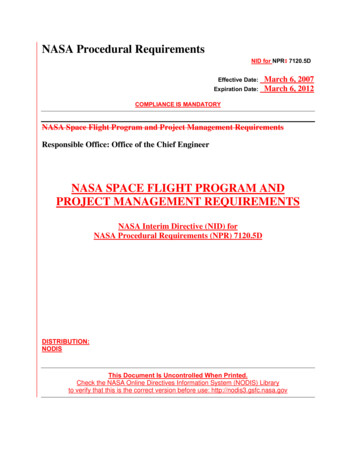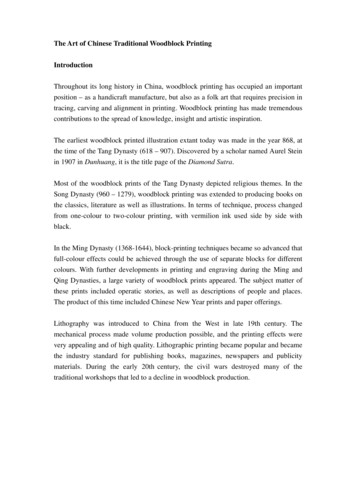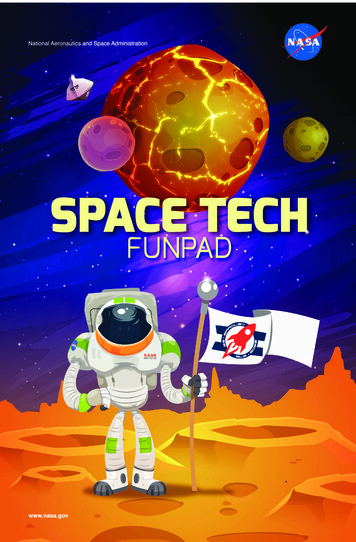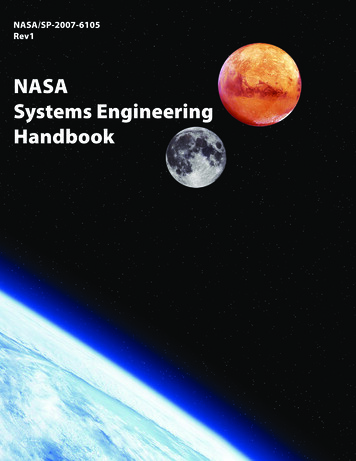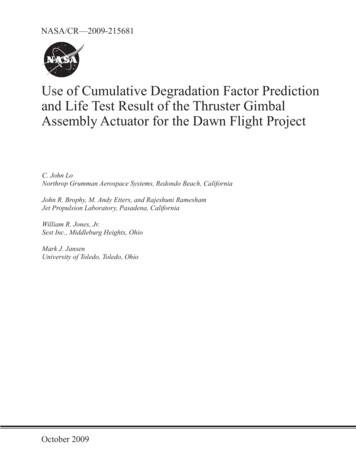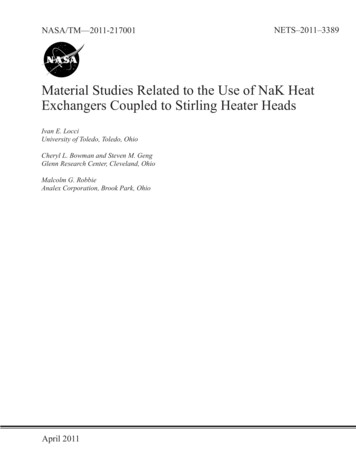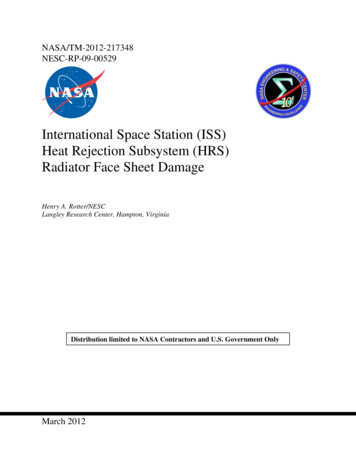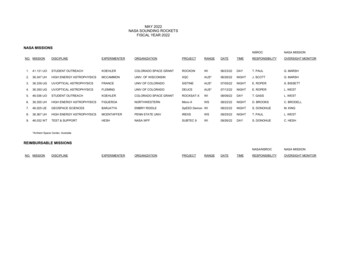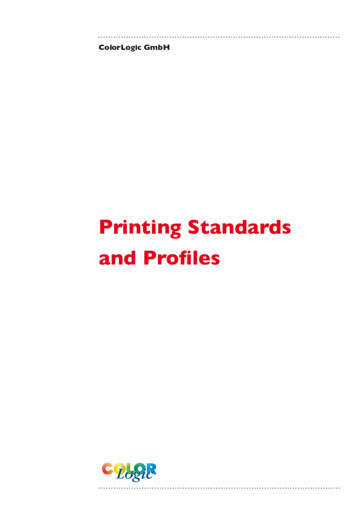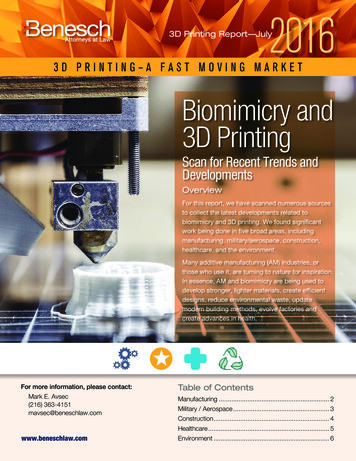
Transcription
20163D Printing Report—July3D PRINTING–A FAST MOVING MARKETBiomimicry and3D PrintingScan for Recent Trends andDevelopmentsOverviewFor this report, we have scanned numerous sourcesto collect the latest developments related tobiomimicry and 3D printing. We found significantwork being done in five broad areas, includingmanufacturing, military/aerospace, construction,healthcare, and the environment.Many additive manufacturing (AM) industries, orthose who use it, are turning to nature for inspiration.In essence, AM and biomimicry are being used todevelop stronger, lighter materials, create efficientdesigns, reduce environmental waste, updatemodern building methods, evolve factories andcreate advances in health.For more information, please contact:Table of Contents Mark E. Avsec(216) 363-4151mavsec@beneschlaw.comManufacturing. 2Military / Aerospace. 3Construction. 4Healthcare. 5www.beneschlaw.comEnvironment. 6
3D PRINTING–A FAST MOVING MARKETBiomimicry and 3D Printing Scan for Recent Trends and DevelopmentsManufacturingManufacturers are using 3D printing and biomimicry to develop layered structures that areboth low-weight and extremely strong. Companies are also looking at efficient ways to moldmaterials with methods taken from nature.Demonstrating High-Performance Energy-Efficient Additive ManufacturingHARBEC uses AM and biomimicry to develop ways to efficiently transfer heat and fluidswithin injection molds. Leveraging 3D printing, HARBEC and partners have demonstratedthe potential for “growing molds” that incorporate principles of biomimicry, resulting in moreenergy-efficient and higher-performance molds for manufacturing.3D Printing Biomimicry Leads to Righteous RippingBy combining his knowledge of surfing and board construction with biologically inspiredaerodynamics and additive manufacturing techniques, Roy Stuart is now able to sellperformance enhancing and affordable surfboard fins.Festo’s 3D Cocooner builds 3D structures via a tripod robotPositional data and control signals are sent to the tripod by an animation software programthat uses a 3D shape model to parametrically generate a desired structure. Using themachine, it is possible to construct complex shapes in three-dimensional space without anysupports.The company has also developed 3D printed BionicANTs (Autonomous NetworkingTechnologies) and eMotion Butterflies. The ANTs take not only their form but also theirprogrammed behavior from nature, communicating with one another to coordinate actionand movement. Festo believes the factory of tomorrow will be founded on intelligentcomponents that can adjust themselves to different production scenarios as the ANTs do.UC Berkeley, Autodesk Use Biomimicry to Develop Eco-Friendly3D-Printing MaterialsAutodesk is backing work from students at the UC Berkeley Center for Green Chemistrywho are focusing on developing materials to replace stereolithography (SLA) resins, whichare known toxins and have already proven deadly to aquatic life.Butterfly Wings Inspire Aussie Scientists to 3D Print Stronger Structures for theFuture of ElectronicsAn important part of Callophrys Rubi’s anatomy may be the catalyst for a true breakthroughin the optics and photonics industries, areas which are continually improving uponthemselves due to a competitive marketplace and constant customer demand.2
3D PRINTING–A FAST MOVING MARKETBiomimicry and 3D Printing Scan for Recent Trends and DevelopmentsUltimately, their goal was a structure that’s more durable and resilient and lightweight. Asusual, we want it all—but often, 3D printing is capable of giving that; in fact, the researchteam was able to cash in on virtually every benefit the technology has to offer, taking atraditional design and improving on it with unprecedented customization in this field, alongwith enjoying the self-sustainability of creating and re-creating models in the lab, all the whilecreating greater speed and higher resolution, and undoubtedly affordability. The team’sparticular 3D technique allows also for uniquely strong architectures, with accompanied highresolution.Military / AerospaceThe Military and Aerospace industry is looking at biomimicry and 3D printing to developstronger, lighter, more resilient materials. Developments include impact-resistant helmets,flexible armor, and lightweight wings able to travel long distances.Micro Air Vehicles Go Batty for BiomimicryInnovative membrane wings that work like artificial muscles have been successfully testedin-flight, paving the way for a new breed of unmanned Micro Air Vehicles (MAVs) that haveimproved aerodynamic properties, can fly over long distances and are more economical torun. Inspired by bats, the wings change shape in response to the forces they experienceand have no mechanical parts, making MAVs incorporating them easier to maintain.Researchers Developing Super-Strong Materials Thanks to a 3D Printer and theMantis ShrimpWe knew from previous studies that the impact region allows the mantis shrimp to transferincredible momentum to its prey while resisting fracture, but it was exciting to reveal throughour research that the properties of this highly impact-resistant material are created by thenovel herringbone structure.Learning from fish to develop new materialsBulletproof uniforms and space suits impervious to micro-meteorites are two of the potentialapplications for new materials developed at the Technion-Israel Institute of Technology.Innovation inspiration: What bones taught airbus about optimizing strengthThe Airbus Group is taking innovation inspired by nature to the air by using 3D printing tohelp build a stronger, lighter-weight galley partition that mimics cells structure and bonegrowth.3
3D PRINTING–A FAST MOVING MARKETBiomimicry and 3D Printing Scan for Recent Trends and DevelopmentsConstructionIndustries are looking to AM and biomimicry to create lightweight, renewable, and efficientmeans of constructing homes and buildings.Siemens: 3D Printing Spider Bots are Able to Collaborate in Smart Printing Teams,Covering Ground AutonomouslyResearchers at Siemens in New Jersey have developed artificially intelligent 3D-printedspider bots that work in teams to 3D print large structures. Researchers are developing theirbots for the marine and aerospace industries and anticipate that they will be responsible forconstruction of parts such as fuselages and hulls.A Mind-Blowing Dome Made by 6,500 Computer-Guided SilkwormsThe Silk Pavillion—an architectural experiment constructed at MIT, was “3-D printed” using6,500 live silkworms.NASA 3D-Printed Habitat ChallengeNASA has announced the winners of its 3-D Printed Habitat Challenge Design Competition.The contest sought architectural concepts for how 3D printing might be used to createshelters on the Red Planet. The overall winner, Ice House, would be built using the planet’spredicted abundant water supply.Israeli Researchers Develop Algorithm for Self-Assembling 3D Printed ObjectsThe findings showed that high frequency vibrations can be used to aide bricks in selfassembling into a larger 3D object—a phenomenon that could dramatically change thefuture of consumer product assemblies. “Assembly rules are encoded by topographiccues imprinted on brick faces while attraction between bricks is provided by embeddedmagnets,” explained the researchers in their paper. “The bricks can then be mixed in acontainer and agitated, leading to properly assembled objects at high yields and zeroerrors.”4
3D PRINTING–A FAST MOVING MARKETBiomimicry and 3D Printing Scan for Recent Trends and DevelopmentsHealthcareThe healthcare industry is combining AM with biomimicry to print tissues. Advances inthis area have led to ‘bio-printing.’ This medical advance may lead to the actual printing ofskin, bones, and organs. Biomimicry also may allow for the creation of ‘scaffolds’ madeof materials compatible with the body and fashioned in the shape of a tissue or organ;cells, ideally from the patient; and biomolecules, such as growth factors, to induce tissueformation.Bioprinting: 3D Printing Comes to LifeWhile numerous biologic tissues have been printed and tested pre-clinically, challengesremain to further develop and harness 3D printing technologies for more complex tissuesand organs. As scientists move away from modifying existing printers and begin to designnew technologies, the range of materials can be extended and methods to deposit materialsand cells with increasing precision and specificity can be developed.3D Printing of Scaffolds for Tissue Regeneration ApplicationsThe current need for organ and tissue replacement, repair and regeneration for patientsis continually growing such that supply is not meeting the high demand primarily due to apaucity of donors as well as biocompatibility issues that lead to immune rejection of thetransplant. In an effort to overcome these drawbacks, scientists working in the field oftissue engineering and regenerative medicine have investigated the use of scaffolds as analternative to transplantation.Pleurobot the 3D Printed Salamander Yields Helpful Data for Researchers Hopingto Help Paraplegics & AmputeesThe hope is for part of a more noble cause in that with this research they will be able totranslate some of this knowledge into helping paraplegic patients and amputees withcreating improved neuroprosthetic devices—an area where both 3D printing and roboticshave been heavily integrated of late.5
3D PRINTING–A FAST MOVING MARKETBiomimicry and 3D Printing Scan for Recent Trends and DevelopmentsEnvironmentBiomimicry is being used in the very process of additive manufacturing (AM). This canhappen through the energy needed for the 3D printers to operate and the materials used.Manufacturers are turning to nature to create renewable sources of AM materials whilestudying the animal kingdom for methods of extruding the materials.Nature Is The Ultimate 3-D Printer: Can We Make Our New ManufacturingAs Clean?I believe biomimicry will be vital to four key aspects of this vision: local sourcing, smartstructure, safe chemistry, and reverse logistics. After 3.8 billion years of making majesticdesigns from simple materials, nature has much to teach us. Imagine sourcing our 3-Dprinter polymers from CO2 (as plants do) or waste carbohydrates (as animals do). Forstructure, imagine borrowing organisms’ highly evolved blueprints, just as Harvard’sDon Ingber did to create an aluminum-strong, insect-inspired plastic named “shrilk.” Thechemistry inside the printer, if modeled on nature’s recipe book, could retire the “heat, beat,and treat” of old industrial processes. The same chemistries that build a product from thebottom up can be reversed to break it down, allowing materials to be reincarnated into newproducts, just as the nutrients in a log find their way into insects, then rodents, then hawks.Taken to its full extent, this biologically inspired manufacturing system would signal a seachange in our materials economy.Towards Sustainable ‘Biofriendly’ Materials for Additive ManufacturingLearning from the patterns and strategies found in nature—which have taken eons toevolve—can help guide the way to sustainable innovation.Nature already assembles everything using incredibly sustainable biofriendly processes.The highly complex results are made from 100% renewable resources, and (the Law of theJungle notwithstanding) are typically non-hazardous to other living organisms.Bio-Inspired 3D Printed Row-Bot Cleans Water Surface as it “Eats” BacteriaInspired by the aquatic water boatman beetle, Researchers at the University of Bristol havecreated a 3D printed robot that can self-propel, or ‘row’, along the surface of lakes andponds, consuming microbes as it goes. Since the row-bot is powered by the microbes iteats, it does not require any recharging, and has the potential to be used in environmentalmonitoring and water clean-up systems.6
Don Ingber did to create an aluminum-strong, insect-inspired plastic named “shrilk.” The chemistry inside the printer, if modeled on nature’s recipe book, could retire the “heat, beat, and treat” of old industrial proc
